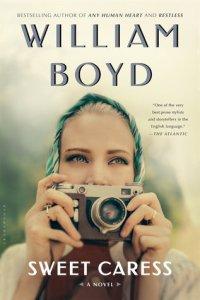
What’s it all about?:
When Amory Clay was born, in the decade before the Great War, her disappointed father gave her an androgynous name and announced the birth of a son. But this daughter was not one to let others define her; Amory became a woman who accepted no limits to what that could mean, and from the time she picked up her first camera, one who would record her own version of events.
Moving freely between London and New York, between photojournalism and fashion photography, and between the men who love her on complicated terms, Amory establishes her reputation as a risk taker and a passionate life traveler. Her hunger for experience draws her to the decadence of Weimar-era Berlin and the violence of London’s Blackshirt riots, to the Rhineland with Allied troops and into the political tangle of war-torn Vietnam. During her ambitious career, the seminal moments of the twentieth century will become the unforgettable moments of her own biography as well.
In Sweet Caress, Amory Clay comes wondrously to life, her vibrant personality enveloping the reader from the start. And, running through the novel, her photographs over the decades allow us to experience this vast story not only with Amory’s voice but with her vision. William Boyd’s Sweet Caress captures an entire lifetime unforgettably within its pages. It captivates.
What did I think?:
I haven’t read much by William Boyd before although I am very aware of the genius of his writing and Sweet Caress is a beautiful example of just how amazing he can be. What makes this book really special though, is the inclusion of multiple photographs (supposed to be taken by Amory) but actually amassed from Boyd’s own collection of intriguing and anonymous photographs he has amassed. The entire narrative has actually been written around and occasionally altered by the author to fit some of the photos. It blends historical fact and fiction seamlessly to the extent that I actually had to go investigating after reading this novel as to whether Amory Clay as a person actually existed! Unfortunately, she seems to be entirely fictional but it represents the strength of writing that I actually believed this woman was a “real life” historical figure.
The story is told in two parts – the first is Amory’s journal entries from the 1970’s where she is happily ensconced on a Scottish island enjoying her retirement and taking the occasional photographs, her one true passion and something she did very successfully in her youth to middle age. Then as Amory reminisces over her life, we learn of her early life experiences at boarding school, her troubled relationship with her father – a war hero who has been deeply psychologically affected by what he experienced during the war and, as a result, tries to kill both Amory and himself by driving their car into a lake.
Her life continues to fascinate and compel the reader as by defying the standards of society at that time as to what is an acceptable career for a woman and she is determined to become a world class photographer. She starts small with the help of her uncle by assisting him in photographing society ladies but soon develops a bit of a reputation for herself when she starts to push the boundaries of what photographs should show. This leads to her completing occasionally risky assignments, like going to the brothels of Berlin in the 1920’s, covering fascist riots in London in the 1930’s and being very close to the front-line in World War II and Vietnam. She makes some very wobbly decisions regarding her career, her personal safety and the men she chooses to love but despite everything comes across as an independent, dynamic and endlessly intriguing character that led such an admirable and exciting life.
I simply loved Amory as a character and because the reader gets to see her whole life in its entirety from tentative girl to assured and brave woman, you really felt like you knew her and when it ended, it almost felt like you were leaving a friend behind. As I mentioned before, the beauty of Boyd’s words is increased exponentially by his decision to include some riveting photographs that really enhanced the text and the story as a whole. Even though some of the images were quite shocking (I’m thinking of a particular photo showing a dead German soldier), you couldn’t help but go backwards to look at them again and I thought it was a really unique way to tell a story. I’ll definitely be checking out some more of William Boyd’s work – he’s a force to be reckoned with!
Would I recommend it?:
But of course!
Star rating (out of 5):


